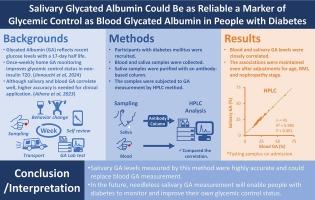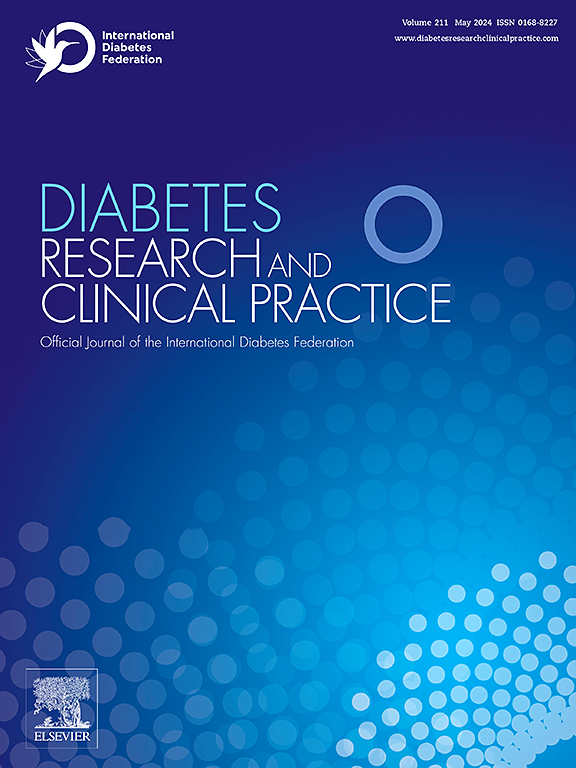唾液糖化白蛋白与血液糖化白蛋白一样,可以作为糖尿病患者血糖控制的可靠指标。
IF 6.1
3区 医学
Q1 ENDOCRINOLOGY & METABOLISM
引用次数: 0
摘要
目的:要评估血糖控制情况,就必须测量与糖尿病相关的生物标志物。常用的指刺血糖和 HbA1c 测量以及血液糖化白蛋白(GA)测量都是侵入性的。因此,我们开发了一种非侵入性方法,即使用高效液相色谱法(HPLC)测量唾液中的糖化白蛋白(GA),其准确性很高:方法:我们招募了东京大学医院的糖尿病患者。在三个时间点(入院时空腹、餐后 2 小时和出院时空腹)采集血液和唾液样本。使用抗体柱对样本进行部分纯化后,采用高效液相色谱法测量 GA:结果:在参与研究的 56 名糖尿病患者中,在上述三个时间点测量的血液和唾液中的 GA 含量之间存在相关性(n = 45,R2 = 0.985,P 2 = 0.973,P 2 = 0.979,P 结论:研究结果表明,血液中的 GA 含量与唾液中的 GA 含量之间存在相关性(n = 45,R2 = 0.985,P 2 = 0.973,P 2 = 0.979,P 结论):这项探索性研究表明,用这种方法测量唾液 GA 水平是准确的,有可能取代血液 GA 测量。家庭唾液 GA 测量有望得到开发,从而减轻糖尿病患者的负担,减少并发症,提高生活质量。本文章由计算机程序翻译,如有差异,请以英文原文为准。

Salivary glycated albumin could be as reliable a marker of glycemic control as blood glycated albumin in people with diabetes
Aims
Measurements of diabetes-related biomarkers are necessary to assess glycemic control. The commonly used finger-prick blood glucose and HbA1c measurements are invasive, as is blood glycated albumin (GA) measurement. Therefore, we developed a non-invasive method, namely, measurement of the salivary GA with high accuracy using a high-performance liquid chromatography (HPLC) method.
Methods
We recruited participants with diabetes mellitus admitted to The University of Tokyo Hospital. Blood and saliva samples were collected at three time points (fasting and 2-hour postprandial at admission and fasting at discharge). After partial purification using an antibody-based column, the samples were subjected to GA measurement by HPLC method.
Results
Among the 56 participants with diabetes mellitus enrolled in the study, there was a correlation between the GA levels measured in blood and saliva at the three time points described above (n = 45, R2 = 0.985, P < 0.001; n = 48, R2 = 0.973, P < 0.001; n = 51, R2 = 0.979, P < 0.001). Multiple regression analysis revealed the associations were maintained even after adjustments for age, BMI, and nephropathy stage.
Conclusions
This exploratory research revealed that the salivary GA levels by this method were accurate and might be able to replace blood GA measurement. The home salivary GA measurement is expected to be developed that may reduce the burden and complications in people with diabetes mellitus and improve the quality of life.
求助全文
通过发布文献求助,成功后即可免费获取论文全文。
去求助
来源期刊

Diabetes research and clinical practice
医学-内分泌学与代谢
CiteScore
10.30
自引率
3.90%
发文量
862
审稿时长
32 days
期刊介绍:
Diabetes Research and Clinical Practice is an international journal for health-care providers and clinically oriented researchers that publishes high-quality original research articles and expert reviews in diabetes and related areas. The role of the journal is to provide a venue for dissemination of knowledge and discussion of topics related to diabetes clinical research and patient care. Topics of focus include translational science, genetics, immunology, nutrition, psychosocial research, epidemiology, prevention, socio-economic research, complications, new treatments, technologies and therapy.
 求助内容:
求助内容: 应助结果提醒方式:
应助结果提醒方式:


